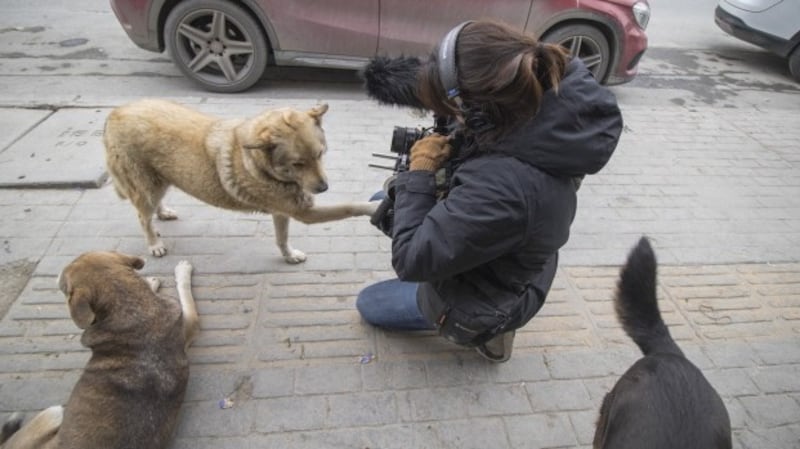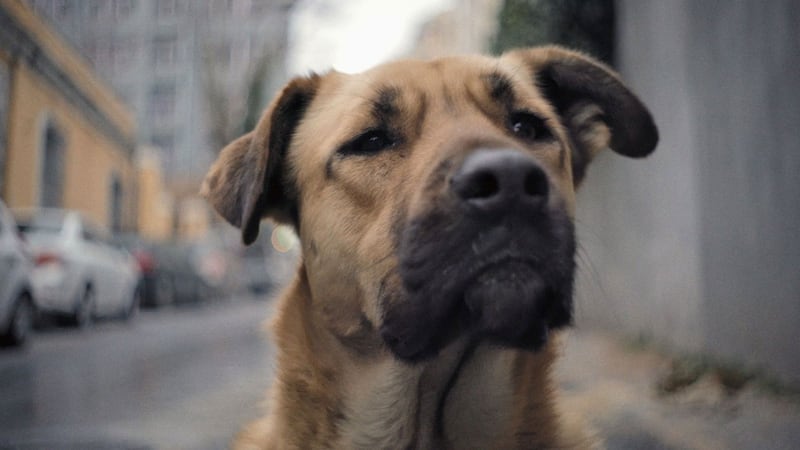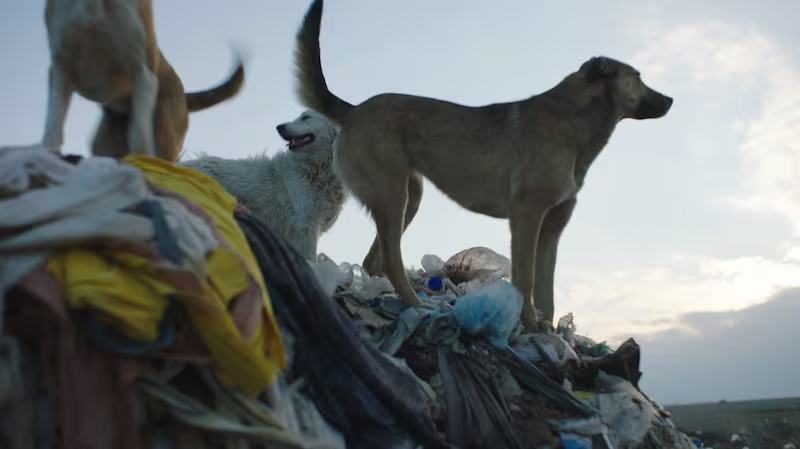Film-maker Elizabeth Lo’s work has played at the Sundance Film Festival, Tribeca and Hot Docs. Many of her documentaries have movingly chronicled socioeconomic inequalities: Hotel 22 focuses on a public bus that, every night, transforms into an unofficial shelter for the homeless in Silicon Valley; Notes from Buena Vista chronicled life at the last working-class mobile home park in salubrious Palo Alto.
Lo is fascinated, too, by speciesism and the asymmetry of relations between humankind and the animal kingdom. Last Stop in Santa Rosa, a short 2015 documentary concerning a hospice for dying animals, follows two elderly dogs and raises some uncomfortable truths about pet euthanasia.
At first it was really frustrating filming stray dogs, because I wasn't able to understand what motivated them
“I’m an animal lover,” she says. “I always try to force myself not to make animal films. But it’s what I’m truly passionate about and what I think about the most. I’ve been a dog lover since childhood. I always wanted to have a dog. I spent years begging my parents. It was actually my childhood dog’s passing that inspired me to want to make the film, Stray.”
There has been considerable chatter around Stray since it premiered at Tribeca last year. Bookended by thoughts from the Greek philosopher Diogenes of Sinope – “Human beings live artificially and hypocritically and would do well to study the dog” – Stray follows three ownerless dogs around Istanbul.
Initially, Lo intended to film strays in different cities. That plan changed, says the Hong Kong-born director, the moment she set foot in Turkey.

“I let go of the idea of doing a global film, because we really wanted the audience to feel for the protagonists of the film in the way that they do for the protagonists of a fiction film,” says Lo. “And to truly engage with them, even if they don’t speak. The dogs of Istanbul are free to move around on their own schedule.”
The protagonist of Stray is Zeytin, a light-brown, medium-sized lady with dark and intense eyes. She is sometimes accompanied by her canine chums, Nazar and Kartal, and by a group of dog-loving Syrian child refugees.
“The Turkish locals were very warm and protective,” recalls Lo. “Some people would try and warn me when I’m filming the Syrians, saying they were dangerous. But everybody loved the dogs and the dogs really brought us together.”
The logistics were daunting. Every night after Zeytin and the other dogs walked Lo back to her hostel, Lo would put a GPS tracking collar on them. That allowed Lo and her producers to locate the dog’s position on a smartphone the following day.
“At first it was really frustrating filming stray dogs, because I wasn’t able to understand what motivated them,” says the film-maker. “I couldn’t understand why they just spent six hours sleeping and then woke up and went off chasing whatever sound or smell, usually something I was not aware of. It was really tough to keep up with them. It was exhausting.
“But over time I got used to the rhythms of a stray dog’s life. Wake up at 5pm. Spend the whole night going on an adventure. Doing the rounds. Joining up with other packs of dogs. Whatever tickles your fancy. So we just kept at it and, depending on the personality of the dog, I kind of got to know what they were interested in.
“I adapted to their way of life, which was much slower, but then had these bursts of hyperactivity. So those were some of the challenges. Because dogs do not understand the pressure of a regular production.”
The leading lady, meanwhile, remained above such petty human concerns as film-making.
“She became the dog I was closest to,” says Lo. “But she was also the most stand-offish of all of the dogs, and the most independent. We thought about putting a collar and leash on her so we could lead her to a place where we wanted to film her. But the moment the collar touched her, she refused to move. She just sat down. She was impossible to coax.
For me, it was important to respect the literal viewpoint of the protagonist
“We were trying to bribe her when she was really sleepy, whenever the film wasn’t going the way that we hoped. She wouldn’t yield. There was nothing we could do to change her mind. That became the real premise of the film: where will dogs take you if you let them.”
Alexandra Horowitz, the cognitive scientist and author of Inside of a Dog, has often characterised dogs as the "anthropologists among us", as they spend their lives watching and studying humans. Lo has returned that scholarship in kind by shooting with a camera rig that mimics a dog's-eye view. Moreover, Ernst Karel, Stray's sound designer, lifted all the frequencies to match the higher range that can be heard by a dog. The effect is a genuine shift away from anthropocentric ways of seeing.
“For me, it was important to respect the literal viewpoint of the protagonist,” says Lo. “So why not use all the tools of cinema available to you, including shooting at their height? It feels really important for me to allow the viewer to access that world view, because this film is all about different world views.”

Istanbul has a very particular relationship with its street dogs. It’s not simply that the dogs are allowed to roam freely: they are cared for by the community, a civic duty that was explored in Kedi, Ceyda Torun’s much-loved 2016 documentary on the cats of Istanbul.
The city’s relationship with dogs and cats can be partly attributed to Islamic influence. The Koran contains several passages that recognise animal autonomy: “There is not an animal that lives on the earth, nor a being that flies on its wings, but they form communities like you” (Koran 6:38).
And others that promote animal care: “Seest thou not that it is Allah Whose praise all beings in the heavens and on earth do celebrate, and the birds [of the air] with wings outspread? Each one knows its own [mode of] prayer and praise. And Allah knows well all that they do” (Koran 24:41). Islam forbids branding animals and killing them for sport, capturing birds, burning anthills and whipping animals.
There is, additionally, a weighty historical context, though that history has not always been illustrious. Visiting what was then called Constantinople in 1867, Mark Twain wrote that he had never seen such “doleful and broken-hearted stray dogs”.
For the past century, debate about the best way to treat ownerless dogs has been a hot topic in Turkey. In an attempt to “westernise” the city just before the fall of the Ottoman Empire, Sultan Mehmed V ordered tens of thousands stray dogs from Istanbul to be exiled to the nearby island of Sivriada, resulting in the 1910 Hayirsizada Dog Massacre, which resulted in about 80,000 strays being left to starve.
What I miss most about Istanbul is the feeling of being able to walk into the street and make friends with a dog on their own terms
“There are passages in the Koran that celebrate other species, seeing them as civilisations on to themselves, which indicates a different level of respect than is found in Christian religions,” says Lo. “I asked a lot of working people in Turkey – especially the butchers and the waiters – why they bother getting up at 6am to sort out all the scraps for dogs and cats and seagulls. And they all point to the Koran asking them to feed those in need, even if they are silent.
“I don’t know if you’re aware of the story about the British diplomat who came to Istanbul and he was chased by a pack of stray dogs and fell to his own death. The British government, with outsized retaliation, forced the Turkish government to round up all unattended animals and brought them to an island.
“At night the Istanbulites could hear the dogs howling and shortly afterwards fires broke out in the city because there were no dogs to warn people and wake them up. And then the first World War happened. So when you talk to people, there is this belief that the exiling of the dogs was a curse on Turkey and Istanbul.”

Turkey has a “no kill, no capture” law towards all its stray animals, including the 100,000 or so dogs that roam the streets of Istanbul. Turkish cities run trap, tag and release programmes, wherein the dogs are captured, vaccinated, neutered or spayed and released back where they were found. They peaceably live alongside the human population, sleeping in parks and on street corners,living on scraps that the locals provide.
“If you were born a dog in New York City, you have no right to exist in a public space,” says Lo. “You have to have an owner, and even if you have an owner there are many places where you have to be leashed.
“Having seen the way stray dogs live in Istanbul, they live life to such a glorious degree. And compare that to dogs who live most of their lives either indoors or constrained by leash. It’s insane when you think about it.
“According to the western definition of a city – think of Paris, London, New York – you don’t see stray dogs because they’re all eradicated or locked up. What I miss most about Istanbul is the feeling of being able to walk into the street and make friends with a dog on their own terms.”
Stray is on demand from March 26th













